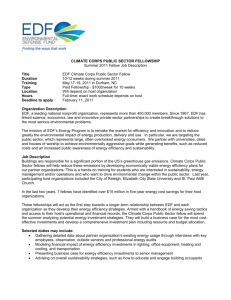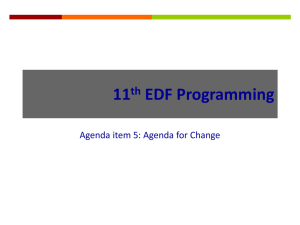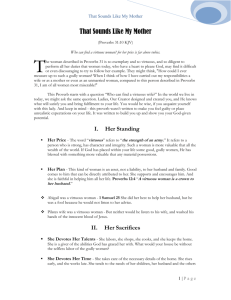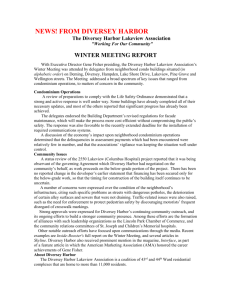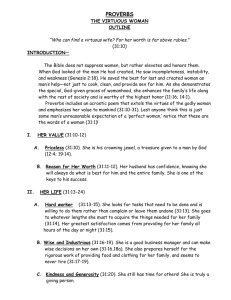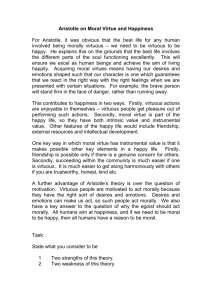The Virtuous Cycle of Organizational Energy Efficiency:
advertisement
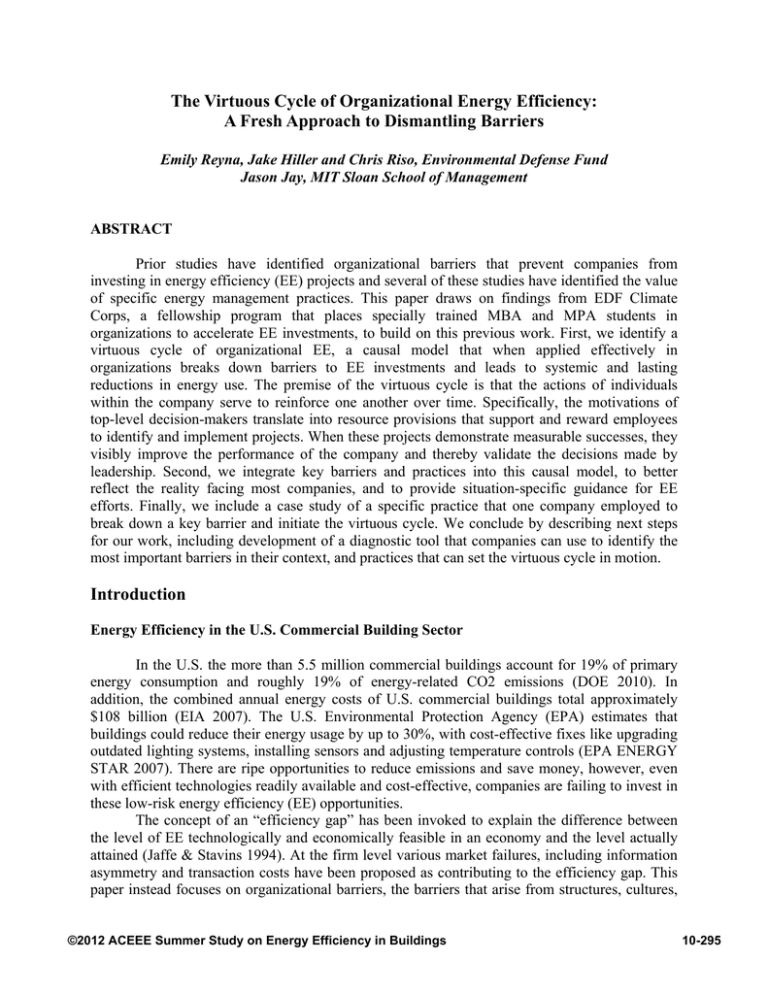
The Virtuous Cycle of Organizational Energy Efficiency: A Fresh Approach to Dismantling Barriers Emily Reyna, Jake Hiller and Chris Riso, Environmental Defense Fund Jason Jay, MIT Sloan School of Management ABSTRACT Prior studies have identified organizational barriers that prevent companies from investing in energy efficiency (EE) projects and several of these studies have identified the value of specific energy management practices. This paper draws on findings from EDF Climate Corps, a fellowship program that places specially trained MBA and MPA students in organizations to accelerate EE investments, to build on this previous work. First, we identify a virtuous cycle of organizational EE, a causal model that when applied effectively in organizations breaks down barriers to EE investments and leads to systemic and lasting reductions in energy use. The premise of the virtuous cycle is that the actions of individuals within the company serve to reinforce one another over time. Specifically, the motivations of top-level decision-makers translate into resource provisions that support and reward employees to identify and implement projects. When these projects demonstrate measurable successes, they visibly improve the performance of the company and thereby validate the decisions made by leadership. Second, we integrate key barriers and practices into this causal model, to better reflect the reality facing most companies, and to provide situation-specific guidance for EE efforts. Finally, we include a case study of a specific practice that one company employed to break down a key barrier and initiate the virtuous cycle. We conclude by describing next steps for our work, including development of a diagnostic tool that companies can use to identify the most important barriers in their context, and practices that can set the virtuous cycle in motion. Introduction Energy Efficiency in the U.S. Commercial Building Sector In the U.S. the more than 5.5 million commercial buildings account for 19% of primary energy consumption and roughly 19% of energy-related CO2 emissions (DOE 2010). In addition, the combined annual energy costs of U.S. commercial buildings total approximately $108 billion (EIA 2007). The U.S. Environmental Protection Agency (EPA) estimates that buildings could reduce their energy usage by up to 30%, with cost-effective fixes like upgrading outdated lighting systems, installing sensors and adjusting temperature controls (EPA ENERGY STAR 2007). There are ripe opportunities to reduce emissions and save money, however, even with efficient technologies readily available and cost-effective, companies are failing to invest in these low-risk energy efficiency (EE) opportunities. The concept of an “efficiency gap” has been invoked to explain the difference between the level of EE technologically and economically feasible in an economy and the level actually attained (Jaffe & Stavins 1994). At the firm level various market failures, including information asymmetry and transaction costs have been proposed as contributing to the efficiency gap. This paper instead focuses on organizational barriers, the barriers that arise from structures, cultures, ©2012 ACEEE Summer Study on Energy Efficiency in Buildings 10-295 and behaviors within the firm. These organizational barriers include competing priorities, information gaps, incentive structures, and budget constraints. While many barriers and leading practices for energy management have been identified in the literature (Bazerman 2008; Kulakowski 1999; Prindle 2010; Sorrell et al. 2000; Thollander et al. 2010; Weber 1997), the authors are unaware of any detailed attempt to model these factors and explain how they influence one another at the level of the individual firm. In this paper the authors propose such an integrated model, taking the form of a causal loop of energy performance improvement. The model suggests stages along a pathway to energy improvement and the barriers that can impede progress at each point. The model also offers a number of interventions that can help to overcome these barriers. This model was produced with knowledge gained through Environmental Defense Fund’s (EDF) experience working with Fortune 1000 companies participating in the EDF Climate Corps program, described in the Methods section. The Virtuous Cycle of Organizational Energy Efficiency We have observed two principal dynamics by which EE initiatives begin in companies: top-down and bottom-up. Common to both is the observation that new initiatives always start with the actions of individuals. The most effective initiatives demonstrate elements of both approaches. In top-down approaches, management, often the CEO or another senior executive, decides to make a strategic shift in the way the company captures value from wasted energy. This typically leads to investments in centralized resources or the establishment of new company policies. Top-down initiatives have the potential to create significant momentum for change through the actions of one or only a few key decision-makers. The organizational change literature, however, has shown that without effectively engaging the employee base to take ownership of the initiatives quickly, they can ultimately lose that initial momentum and fail to produce lasting improvements (Kotter 1996; Senge et al. 1999). In bottom-up approaches, the initial action is driven by employees themselves, for example facility managers, office workers, or another group of energy users who organize in order to effect change directly. Such efforts have the advantage of early enthusiasm and engagement, but will eventually fail if they do not gain the attention of decision-makers with the funding authority to provide resources needed to scale and sustain those initiatives. How then do successful organizations ensure that EE initiatives—whether they are driven from the top or bottom—continue to operate successfully and achieve sustained performance improvements? The key is to ensure that the actions of individuals within the company serve to reinforce one another over time. Specifically, the motivations of top-level decision-makers need to translate into resource provisions that support and reward the employees to identify and implement projects. The projects need to translate into measurable successes that visibly improve the performance of the company and validate the decisions made by leadership. This self-reinforcing dynamic can be visually depicted using a causal loop diagram following the conventions of system dynamics (Sterman 2000). A chart depicting the causal loop is shown in Figure 1. While this theory initially emerged from the study of a few particular EDF Climate Corps companies, the resulting model can be applied to a wide range of corporations. We have observed these dynamics in almost every EDF Climate Corps company we have studied, and it has a similar form to other models of successful organizational change (Senge et al. 1999). ©2012 ACEEE Summer Study on Energy Efficiency in Buildings 10-296 Figure 1. The Virtuous Cycle of Organizational Energy Efficiency Arrows indicate the direction of causality. The plus signs at the arrowheads indicate direct causal relationships (i.e., the downstream variables increase or decrease with the upstream variables). This reinforcing feedback loop can thus function as either a “virtuous” or “vicious” cycle. Here we emphasize the former. The virtuous cycle is a generative mechanism for high energy performance. Executive engagement enables resource investment (i.e., money and time) for EE efforts. Those resources enable people and tools throughout the organization to identify and quantify opportunities for EE, and to implement projects that result in economic and environmental wins. When the results and stories are quantified, spun into a compelling narrative of success, and publicized, executive engagement increases further. Reinforcing feedback loops (denoted by the “R”) can generate exponential growth or decay. In this case, the virtuous cycle, left unimpeded, can generate exponential growth in energy performance. Because it is a loop, it can start at any point, but we find it most useful to think of executive engagement or people and tools as starting points since initiatives start with the actions of individuals. The challenge of organizational EE efforts is that growth in performance is constrained by a set of limited “stocks” of available opportunities, bandwidth, attention, budget, and capability. As these run out, growth is inhibited. The result is a set of negative or balancing feedback loops (denoted by “B” in Figure 2) that limit the growth of efficiency initiatives. For example, an organization that initiates the virtuous cycle might identify and implement various quick win projects in the first few years. Over time the stock of available quick win opportunities will diminish, reducing the number of projects the company is willing to implement. Less implementation means less results and stories and the virtuous cycle slows. As a metaphor, the reinforcing loop can be seen as a kind of flywheel, spinning up and carrying the momentum of the organization, while the balancing loops are like brakes applied to the flywheel. The balancing loops borrow the central insight from Senge et al. (1999), whose research identified a similar array of limiting dynamics for efforts at organizational learning and change. ©2012 ACEEE Summer Study on Energy Efficiency in Buildings 10-297 Figure 2. Full Model of Virtuous Cycle, Barriers, and Practices Arrows indicate the direction of causality. The center loop is the virtuous cycle, which is positive and reinforcing (denoted by "R"). The outer loops are negative and balancing (denoted by "B"). They depict the diminishing "stocks" which act as barriers to keeping the virtuous cycle in motion. The minus signs at the arrowheads indicate inverse causal relationships (e.g., an increase in resource investment causes a decrease in the stock of available budget). Practices (e.g., dedicated financing) are displayed as inputs to the balancing loops and act to replenish the limited stocks and to enable the virtuous cycle. While there are many constraints that may limit companies' energy management success, our observations have found these five—limited stocks of opportunities, bandwidth, attention, budget, and capability—to be the most pervasive barriers to this virtuous cycle. The key to setting the virtuous cycle in motion is to overcome these constraints by developing practices, policies, and tools that serve to expand or replenish the limited stocks being dissipated. Figure 2 also shows examples of best practices for overcoming the constraints. The practice of providing dedicated EE financing, for example, positively impacts the stock of available budget and ensures continued resource investment for EE projects. More practices are illustrated in the case study of Diversey in the Results section below, and in the accompanying Table 2 outlining practices in Diversey and other EDF Climate Corps companies. This is by no means, however, a comprehensive array of practices. Our goal is to highlight what high leverage practices accomplish: overcoming constraints and enabling a virtuous cycle of energy performance. In fact, the practices with highest leverage are those that affect multiple constraints simultaneously. We see this in Diversey’s centralized capital budgeting practice and in its portfolio-based management practices, described below. ©2012 ACEEE Summer Study on Energy Efficiency in Buildings 10-298 Methods EDF Climate Corps Program Overview EDF has a 20-year history of working with leading corporations to demonstrate that good environmental strategy is synonymous with good business strategy. EDF launched the Climate Corps fellowship program to seize the enormous opportunity to cut costs and greenhouse gas emissions by improving energy efficiency in buildings. McKinsey & Co. estimates that by 2020, the United States could reduce its annual energy consumption by 23% through energy efficiency measures, cutting greenhouse gas emissions by over a gigaton, and saving over a trillion dollars (McKinsey & Company 2009). And yet, many companies routinely fail to capture even costeffective efficiency opportunities because of lack of bandwidth and expertise, competing business priorities, and disincentives to work across departments. EDF created Climate Corps to overcome these barriers. By delivering a laser-like focus and a compelling business case for energy efficiency, Climate Corps fellows work with their host organizations to save energy, cut costs and reduce GHG emissions. During the course of a 10 to 12-week summer, each fellow develops a customized and prioritized energy efficiency investment plan for the host organization that recommends specific energy-saving measures and projects their financial and environmental benefits. Pulling high-priority investments together into a compelling business case is critical to securing CFO-level support for their recommendations, and ensuring successful implementation. Since its launch in 2008, EDF Climate Corps has grown from seven fellows to 96 in 2011, and has expanded in scope to include engagements in corporations, municipal government and universities. From 2008 to 2011, 187 fellows have identified EE projects that could create over $1 billion in net operational cost savings over the project lifetimes, and have the potential to avoid one million metric tons of annual CO2e emissions for participating organizations. Projects accounting for 86% of the energy savings identified by 2008-2010 fellows are complete or underway, representing over $50 million in new investments in energy efficiency. While the benefits generated by this fellowship program have been substantial, EDF recognizes the unique opportunity fellows have to assist organizations in building capacity for continued improvement in energy performance beyond the fellow’s specific project recommendations. This strategy involves three elements for EDF Climate Corps: (1) to understand the barriers to EE that companies face, (2) to identify the leading practices that top companies are using to overcome these barriers, and (3) to build the capacity of companies to engage in smart, on-going energy decision-making and implement effective energy management practices. At the conclusion of each summer, EDF hosts a conference to debrief the experiences of the fellows and companies. It is through this informal practice sharing and storytelling that the virtuous cycle model began to emerge. In 2011, this knowledge building process was enhanced in two ways. First, EDF engaged with the MIT Sloan Initiative for Sustainable Business and Society and the Society for Organizational Learning to help facilitate a more systematic process of reflection and theory building in the fall conference. Second, EDF deployed a systematic survey of companies through the On-Boarding Tool detailed below. ©2012 ACEEE Summer Study on Energy Efficiency in Buildings 10-299 Description of 2011 On-Boarding Tool In order to collect quantitative and qualitative data on energy management in Climate Corps companies, EDF developed a survey instrument and piloted it with the 2011 cohort. Objectives. The survey, known as the EDF Climate Corps On-Boarding Tool, was developed to illuminate the barriers to EE faced by companies and identify the range of practices being employed to overcome these barriers. A secondary and equally important purpose of the survey was to support successful engagements by helping to orient fellows. In completing the survey together with host company staff, fellows familiarized themselves with company priorities, policies, and practices related to EE, located relevant internal data sources, and initiated conversations with key decision-makers. This data helped to inform final recommendations made by the fellows. Survey design. EDF compiled a set of 57 questions designed to capture detailed information about corporate EE strategy and energy management capacity. Information from three preceding years of EDF Climate Corps company engagements and a literature review of similar surveys informed the survey's content. Questions covered key areas including energy and emissions reduction goals, data collection and reporting systems, benchmarking practices, staff responsibilities, capital budgeting, and lease structures, among others. The 57 survey questions included multiple-choice and free response formats. Deployment and sampling. In total, the On-Boarding Tool was administered on-site to 45 of the 49 total companies in the 2011 cohort, with fellows uploading the information provided into a centralized EDF database. This process ensured that a high response rate was achieved (over 92%), individual company responses were made as complete as possible, answers were vetted by multiple company representatives, and data was collected in a consistent way for analysis. Company respondents represented a broad cross-section of industry sectors and sizes. Respondents ranged from healthcare to electric utilities, financial services, apparel makers, technology and food and beverage, among others. Their annual revenues ranged from $5 million to greater than $100 billion and their number of employees ranged from less than 1,000 to greater than 250,000. Analysis. Because many of the questions were free response and yielded only qualitative data, the first step of analysis was coding these data into distinct categories. For example, responses to the question regarding specific funding mechanisms for EE projects demonstrated an important range of practices, from a majority of companies who do not use any specific mechanisms to ensure annual funding of EE, to other groups of companies that use either environmental key performance indicators (KPIs), preferential set-aside funds, dedicated annual funds, or even advanced portfolio approaches that incorporate cost of carbon considerations, to ensure that EE projects receive funding each year. A team of six researchers established a consensus coding scheme for survey responses and then coded the data in small teams of 2-3 to ensure a degree of inter-coder reliability. ©2012 ACEEE Summer Study on Energy Efficiency in Buildings 10-300 Wherever possible, clear dividing lines between levels of barriers and leading practices were identified in order to map the range of energy management challenges and strategies observed and convert qualitative responses into quantifiable data inputs for additional statistical analysis. An example of one such spectrum of responses is shown below in Table 1. Table 1. Sample Coding of Qualitative Data 0 …indeterminate. Not enough information provided. Special consideration and/or funding for energy efficiency investments are… 1 2 3 4 5 …provided …provided …provided …provided through an …not strategies through through a setthrough a advanced used by our environmental aside fund that dedicated fund portfolio company to fund KPIs built into a gives partial exclusive to approach that energy general capital preference to energy incorporates cost efficiency or operating energy efficient performance of carbon into projects. expense budget. investments. improvement. our funding considerations. After eliminating the blank or indeterminate responses from the pool, a correlation matrix of these variables was created to help identify connections between the various practices organizations use to improve energy performance. A diagram showing these connections is included as Figure 6 of the Results section. This analysis began a process of determining how practices can serve to either reinforce or counteract one another. Based on the findings of the analysis, a number of companies were interviewed to provide more detailed information regarding the process by which their energy management strategies and practices have evolved over time. This investigation informed the creation of a new causal loop model that helps to explain how these processes interact in organizations. Results and Discussion Virtuous Cycle Case Study Building momentum in the virtuous cycle of organizational EE requires both time and persistent, well-targeted effort. The following is an example of one company that is making progress toward comprehensive, self-reinforcing energy management practices. Initiating the virtuous cycle through executive engagement. Diversey, now a part of Sealed Air, is a global leader in providing industrial cleaning, sanitation, and hygiene products. Diversey's focus on environmental issues dates back to the 1930s, when the company created a more sustainable process for extracting Brazilian carnauba wax. This protected the vulnerable supply for their products and bolstered the community where the wax was sourced. Although Diversey implemented a variety of EE and environmental projects in the years leading up to the early 2000s, the company lacked a cohesive long-term environmental strategy. In 2007 executive leadership learned of the World Wildlife Fund's Climate Savers program, a rigorous voluntary greenhouse gas reductions program, and asked managers to consider participation. In 2008, after a year of careful assessment, Diversey became among the first 20 companies to commit to Climate Savers, pledging to reduce greenhouse gas emissions from operations to 8% below 2003 levels by 2013. ©2012 ACEEE Summer Study on Energy Efficiency in Buildings 10-301 Setting the goal. In determining its Climate Savers emissions reduction goal, Diversey began by establishing the financial criteria necessary for the investments that would drive its emissions reductions target. The team set strict requirements, dictating that to be approved projects must have a positive return on investment, a payback period of three years or less, and meet the company's standard hurdle rate, the minimum acceptable rate of return. These decisions recognized that true program sustainability over the long term requires delivering satisfactory financial returns based on uniform corporate criteria. With financial criteria set, the team evaluated numerous investment opportunities, accounted for projected organic growth, and estimated that an 8% emissions reduction would be attainable with $19 million in investment, yielding $32 million in cash savings over the life of the program. Setting a public goal built the momentum necessary to move Diversey through the rest of the virtuous cycle, including the commitment of resources, catalyzing people, and identifying opportunities. With a clear goal, identified projects, and budgetary authority, implementation seemed assured. However, Jeramy Lemieux, Manager of Environment, Health and Safety at Diversey, said that the first year of implementation was much slower than anticipated owing to several challenges. Initial barriers to the virtuous cycle. The first challenge was presented by the traditional financial approach used to assess EE investments. When applying the criteria to their large list of energy projects, it became clear that some projects offered attractive emissions reduction potential but weaker financial returns. Utilizing a simple project-specific payback method and capital cost per metric ton of emissions reduced would result in only 30 projects out of the potential 120 projects meeting investment criteria. This would allow Diversey to meet their 8% goal, but would leave a number of attractive projects on the table, limiting the opportunities for investment. Furthermore, some potential investments in efficiency were actually superfluous. While it may make sense to replace an old boiler with a more efficient one when that boiler is being fully utilized, it would be more cost and energy efficient to avoid using the boiler in the first place if this were possible. The Diversey team started to recognize that achieving small wins might require a change in thinking that involved avoiding energy use altogether. A second challenge encountered related to people. The Diversey team discovered that many of the projects that met all required financial and environmental criteria were not moving forward at the plant level after they were proposed for implementation. They discovered that plant managers lacked the motivation and capability to implement these projects because the projects were not aligned with their priorities and incentives. Managers were being measured on output, so they wanted to focus on investing in projects that would directly contribute to production. Time and resources directed towards EE would detract from these other more pressing goals. In the virtuous cycle model, these challenges are understood as finite stocks of available opportunities and available capabilities, which created a dampening effect (a balancing feedback loop) on the growth of energy performance. The Portfolio Approach to EE Investments. To achieve greater EE and sustain a selfreinforcing cycle Diversey would need to refocus their efforts. The key to success, naturally, would be implementing as many emissions reductions projects as possible. They found that some projects, especially “avoidance” projects, which conserved energy by eliminating unnecessary use, were attractive on short timelines and included a low capital cost. Other projects would ©2012 ACEEE Summer Study on Energy Efficiency in Buildings 10-302 require a more significant capital investment and demonstrate longer payback periods but deliver more potent energy reductions. To combine the benefits of their mix of projects, Diversey constructed an innovative portfolio management approach to prioritization and funding. Rather than evaluating projects as isolated, discrete investments, Diversey began using customized tools to view opportunities on a global scale. This allowed the company to balance a number of factors including payback period, return on investment, the total financial return, and the cost of carbon reduction. The approach reduces uncertainty and risk and diversifies sustainability investments while ensuring a predictable and reliable rate of return. Using a portfolio approach Diversey was able increase the number of investment projects that met their criteria from 30 to 90 out of the original list of 120 projects. They were also able to commit to a more aggressive 25% reduction goal while reducing capital investments from $19 million to $14 million but continuing to deliver the original $32 million in cash savings. Specific examples of the virtuous cycle in motion. This new method of thinking resulted in several best practices that continually reinforce Diversey's virtuous cycle of organizational EE: 1. 2. 3. 4. Executive engagement. Encouragement to make a public Climate Savers goal and the blessing of this new portfolio approach enabled Diversey to build and sustain momentum in the virtuous cycle. As long as a goal is in place, management will continue to pay close attention to these efforts. Additionally, the company’s continuing concern for its historical environmental performance and leadership position should help to replenish its stock of diminished attention even after initial goals are reached. Resource investment. The balanced portfolio approach to energy investments is the best practice that enables Diversey to dedicate budget to energy projects. Lemieux secured a 40% year-on-year budget increase during a time when all other divisions of the company experienced a 50% budget cut because of the availability of data to verify past energy project performance. Diversey also manages the portfolio of projects through a centralized capital budgeting process. This means a stable, dedicated source of funds that has the potential to attract more investment based on strong portfolio return on investment (ROI). Absent this, organizations often reduce available local budgets when energy savings occur, choking out the possibility of reinvestment in further efficiency gains. People and tools. Centralized capital budgeting has also helped to engage and incentivize plant managers who were previously uninterested in implementing efficiency measures. With access to a centralized budget, individual sites are able to receive incremental capital to put towards efficiency projects and are able to keep the energy savings incurred by those projects. They no longer perceive efficiency projects as competition to production or expansion projects and EE projects previously on the bottom of their priority list have moved up. Through this strategy of centralized capital budgeting, Diversey has provided a sustainable stock of available budget. This resource investment had a positive causal effect on people and tools, as Figure 2 indicates. At Diversey, this investment provided managers the motivation and capability to implement and capitalize on opportunities. As the figure further indicates, an alternate approach would have been to directly target the people and tools balancing loop, for example by incentivizing managers via direct performance measurement of EE implementation. Identification, implementation and measurement. As described above, a portfolio approach has enabled Diversey to expand its range of available opportunities. This range ©2012 ACEEE Summer Study on Energy Efficiency in Buildings 10-303 5. is further expanded through a toolkit created to identify, prioritize, and track energy investments. All 182 Diversey sites report globally into a centralized system. This data is used as input for the tools to model savings, identify and prioritize projects. Since this system was initiated, Jeramy says that in every year of planning there have been more projects considered for investment than there were in the previous year. It has effectively removed the constraint of diminishing returns, at least for the time being. The more the company asks questions, the more diverse opportunities it identifies. This increasing array of results is a sign that the virtuous cycle is working. Results and stories. In order to demonstrate progress towards the Climate Savers goal, Diversey created a system to collect and track results. In the future, a project database and dashboard will enable managers to drill down to the status of site-specific projects or take a holistic view of the portfolio of projects across the organization. Sharing the stories that this system will make visible will help Diversey to engage stakeholders within and external to the company. The Diversey case study exemplifies a top-down entry into the virtuous cycle. With executive management’s call to action and a fresh new approach to analyzing and funding energy projects, Diversey has established momentum in its virtuous cycle. Table 2 highlights the specific practices Diversey employs to overcome its barriers as well as practices from other companies studied in the EDF Climate Corps Network. Table 2. EDF Climate Corps Network Leading Practices in the Virtuous Cycle Virtuous Cycle Stage: Executive engagement Resource investment People and tools Actions and wins Results and stories Barrier: Diminishing attention Diminishing budget Diminishing capability Diminishing opportunity Diminishing bandwidth Public Centralized Climate Savers capital budgeting Goal and the ensures a Practices history and legacy protected pool of showcased in the of the company funds. Diversey Case ensures top level Study buy-in. Centralized capital budget avoids competing priorities. Centralized Balanced portfolio approach reporting systems make wins and expands the opportunity set; results visible. easy tools for identifying and prioritizing projects bring more eyes to the problem. Hiring a dedicated A dedicated corporate energy energy efficiency Additional manager ensures fund and/or practices found in attention is revolving loan the EDF Climate maintained. fund ensure Corps network capital is always available. Building energy A real-time and performance into up-to-date personnel database of evaluation and energy projects rewarding success enables decisionmotivates makers to see employees. available opportunities. Leading Practice Examples: ©2012 ACEEE Summer Study on Energy Efficiency in Buildings An energy scorecard identifies top performing projects while also revealing learning opportunities. 10-304 Statistical Results Qualitatively we have shown how a few high leverage practices can relax the key constraints/barriers to EE and generate increasing performance over time. Our survey data, however, suggest that these best practices are not widely or universally adopted. The graph in Figure 5 shows one example of a distribution of practices we have identified—types of special funding mechanisms for energy efficient investments. The responses received for this and other high leverage practices confirm that many of the most advanced practices have only been adopted by a few companies. This is a result of the reinforcing feedback loop we have identified, or the metaphorical idea of a flywheel—the more success companies have, the easier it is to invest in the people and systems it takes to keep momentum. Some companies have accelerated down the track, while others are making efforts to get the flywheel going—it is exactly this “turn of the crank” that EDF Climate Corps fellows try to achieve. Figure 5. Sample Distribution of a High Level Practice The pie chart depicts the number of company survey respondents that indicated using each practice. Often the most challenging questions organizations face in initiating the virtuous cycle is where to start. Where are the best on-ramps to action—which people should be engaged first and which tools should be built first? We believe that the answer to these questions is context specific. Different organizations will run into constraints at different times, and have different latent capabilities to build upon. In future iterations of the survey, we will be including diagnostic questions aimed at identifying the most important limiting constraints in the context, and therefore the most important enabling practices. It is, however, possible to use our sample to analyze whether practices cluster together— are there certain practices that correlate with others, perhaps because they have a cascading or enabling effect? The graphic in Figure 6 provides some insight into this question. We produced this by first creating a correlation table among the various practices we identified in our survey. We then isolated the positive and statistically significant correlations (above a p=.05 threshold). ©2012 ACEEE Summer Study on Energy Efficiency in Buildings 10-305 We then used the UCINet tool, a software package for the analysis of social network data, to create a network graph depiction of these correlations (Borgatti, Everett & Freeman 2002). The network graph depicts how practices are statistically related to each other by drawing a line between the practices. By looking at which other practices a given practice is “connected” to, one can begin to identify which practices might be most likely to influence one another. Figure 6. Network of Correlations Among Practices in the On-Boarding Tool This figure shows that a few practices are particularly central. Centralized energy management, for example, is the most connected item, correlated with six other important practices. By contrast, having a database of opportunities is correlated only with having crossfunctional teams working on EE (perhaps because databases facilitate collaboration). Our readers should take care, however, not to infer causation from correlation. Setting GHG reduction goals, for example, could create the motivation for hiring a dedicated energy manager, or an energy manager might organize the creation of GHG reduction goals. In the spirit of a “virtuous cycle,” these efforts might reinforce each other. The important takeaway is that high performing companies develop a system of practices that support one another in enabling a reinforcing feedback of capability development. And there may be particular elements, like a centralized energy manager, that enable others. Directions for Further Research The virtuous cycle has been informed by the experiences of several EDF Climate Corps companies making progress to improve EE by addressing organizational barriers. While it is a ©2012 ACEEE Summer Study on Energy Efficiency in Buildings 10-306 useful framework for understanding the challenges that companies face, the cycle as articulated in this paper represents only the early stages of a more complete model. As EDF Climate Corps continues working with companies, we will improve the model based on additional observations and hypothesis testing. There are two key limitations of the data we have gathered thus far in supporting the virtuous cycle. First, the cycle could be a basis for a system dynamics model capable of representing change over time. Our data, however, is largely cross-sectional, not longitudinal, with the exception of a few case studies gleaned through interviews. As a result, while the companies we study do seem to be growing their capability over time, their actions have not yet proven their long term efficacy. As we continue to gather data from the annual survey, along with further case studies from new EDF Climate Corps companies, we will be able to more carefully observe the sequence of events in firms and the process of capability development. With this more longitudinal data in hand, it may be possible to translate the causal loop diagram presented here into a computational system dynamics model (Repenning & Sterman 2001). Second, the virtuous cycle model is based on information from a relatively small number of companies. This sampling method could introduce some important selection bias—for example, we know it takes a baseline level of attention and resource investment to fund an EDF Climate Corps fellow. That said, even companies enrolled in Climate Corps are at many different points on the EE journey—some are just identifying their first EE investments, while others are fine-tuning a well-oiled machine. Expanding the sample is essential to validate the model as a useful way to understand diverse organizational approaches to improving EE. We also predict that expansion of the sample size will help reveal innovative practices we have not yet seen for overcoming barriers and accelerating the virtuous cycle. EDF Climate Corps and its research partners at MIT plan to build on this work in several concurrent ways. Collecting more data. First, EDF plans to continue growing the program, engaging with new companies annually and fostering multi-year relationships with participating organizations. This broadening of the participation pool, made possible by the documented value-add that fellows provide for hosts, will increase access to new organizations. Improved retention will allow for greater same-company benchmarking to observe the cycle acting over time and to witness the effects of proposed interventions. In addition, the production of more and increasingly detailed case studies informed by these engagements will enable us to refine the model, further strengthen its empirical foundation, and understand its implications for corporate energy strategy. Refining and sharing tools and resources. The team will refine and streamline the OnBoarding Tool based on our learnings from the first iteration. In addition, we plan to produce a public online diagnostic tool based on the On-Boarding Tool and evolving model. This will support the continued development of the virtuous cycle, and offer useful information to participants about how their EE practices compare with host companies and others. Moreover, EDF Climate Corps and our partners will explore the opportunity to produce a robust computer simulation based on our understanding of how the cycle of organizational EE works in companies. Predictions generated by the simulation could then be tested against real world performance and the results used to better understand how EE develops within an organization and inform further refinements of the model. ©2012 ACEEE Summer Study on Energy Efficiency in Buildings 10-307 Growing the EDF Climate Corps network. Finally, EDF believes strongly in the power of the Climate Corps network to serve a convening role for companies and fellows who want to learn from each other as a community. We are committed to creating the context in which network participants can share experiences and advice regarding which practices are truly effective in breaking down barriers to EE and achieving systemic and lasting reductions in energy use and greenhouse gas emissions. We will continue to host annual gatherings of our companies, fellows, and alumni to build relationships, share knowledge, and generate insights—all in order to catalyze individual and collective action to accelerate energy savings. While an EE investment plan can be developed in one summer, transforming a company's energy management practices may take years. EDF looks forward to continuing our engagement with Climate Corps companies to move them toward their energy and environmental goals. References [DOE] U.S. Department of Energy. 2010. Building Technologies Program. Commercial Building Initiative. http://apps1.eere.energy.gov/buildings/publications/pdfs/commercial_ initiative/cbi_fs.pdf Washington, D.C.: U.S. Department of Energy Bazerman, M. 2008. “Barriers to Acting in Time on Energy and Strategies for Overcoming Them.” Harvard Business School Working Paper, 09-063. Borgatti, S.P., Everett, M.G. and Freeman, L.C. 2002. Ucinet for Windows: Software for Social Network Analysis. Harvard, MA: Analytic Technologies. [EIA] U.S. Energy Information Administration. 2007. “Table C4. Expenditures for Sum of Major Fuels for Non-Mall Buildings, 2003.” 2003 Commercial Buildings Energy Consumption Survey: Building Characteristics Tables. http://www.eia.gov/emeu/cbecs/ cbecs2003/detailed_tables_2003/2003set9/2003excel/c4.xls Washington, D.C.: U.S. Energy Information Administration. EPA ENERGY STAR. 2007. “Fast Facts on Energy Use.” http://www.energystar.gov/index. cfm?c=learn_more.fast_facts. Washington, D.C.: U.S. Environmental Protection Agency. Jaffe, A. & R. Stavins. 1994. “The Energy-Efficiency Gap.” Energy Policy, Volume 22, No. 10: 804-810. Kotter, J. P. 1996. Leading Change. Cambridge, MA: Harvard Business School Press. Kulakowski, S. 1999. “Large Organizations’ Investments in Energy-Efficient Building Retrofits.” Lawrence Berkeley National Laboratory, LBNL-40895. McKinsey & Company. 2009. “Unlocking Energy Efficiency in the U.S. Economy.” http://www.mckinsey.com/Client_Service/Electric_Power_and_Natural_Gas/Latest_thin king/Unlocking_energy_efficiency_in_the_US_economy Prindle, W. 2010. “From Shop Floor to Top Floor: Best Business Practices in Energy Efficiency.” Pew Center on Global Climate Change. ©2012 ACEEE Summer Study on Energy Efficiency in Buildings 10-308 Repenning, N. & J. Sterman. 2001. “Nobody Ever Gets Credit for Fixing Problems that Never Happened: Creating and Sustaining Process Improvement.” California Management Review, Volume 43, No. 4: 64-88. Senge, P., Kleiner, A., Roberts, C., Ross, R., Roth, G. & B. Smith. 1999. The Dance of Change: The Challenges to Sustaining Momentum in Learning Organizations. New York, N.Y.: Doubleday Sorrell, S., Boede, U., O’Malley, E., Ostertag, K., Ragden, P., Schleich, J., Scott, S. & F. Trace. 2000. “Reducing Barriers to Energy Efficiency in Public and Private Organisations.” University of Sussex Science and Technology Policy Research (SPRU). Sterman, J. 2000. Business Dynamics: Systems Thinking and Modeling for a Complex World. New York, NY: Irwin/McGraw-Hill. Thollander, P., Palm, J. & P. Rohdin. 2010. “Categorizing Barriers to Energy Efficiency: An interdisciplinary perspective.” Energy Efficiency, SCIYO Books. Weber, L. 1997. “Some Reflections on Barriers to the Efficient Use of Energy.” Energy Policy, Volume 25, No. 10: 833-835. ©2012 ACEEE Summer Study on Energy Efficiency in Buildings 10-309
